Straight Lines Class 11th Notes - Free NCERT Class 11 Maths Chapter 10 notes - Download PDF
If you are told to go from one end of a cricket ground to the other end, what would you do? You would generally take the shortest path, right? Well, have you noticed that the shortest path between two points is always a straight line? Straight lines are one of the most fundamental parts of geometry, which play a significant role in navigation, architecture, road construction, etc. These NCERT Notes for Class 11 Maths contain the concepts of Slope of a line, Angle between two lines, Different forms of the equation of a line, Distance of a point from a line, etc. Understanding these concepts will help the students grasp more advanced trigonometry topics easily and will also enhance their problem-solving ability in real-world applications.
This Story also Contains
- Class 11 Straight Lines Notes PDF – Download Free Study Material
- Straight Lines Class 11 Notes
- Straight Lines Class 11 Notes: Previous Year Question and Answer
- Importance of NCERT Class 11 Maths Chapter 9 Notes
- NCERT Class 11 Maths Notes Chapter-Wise Links
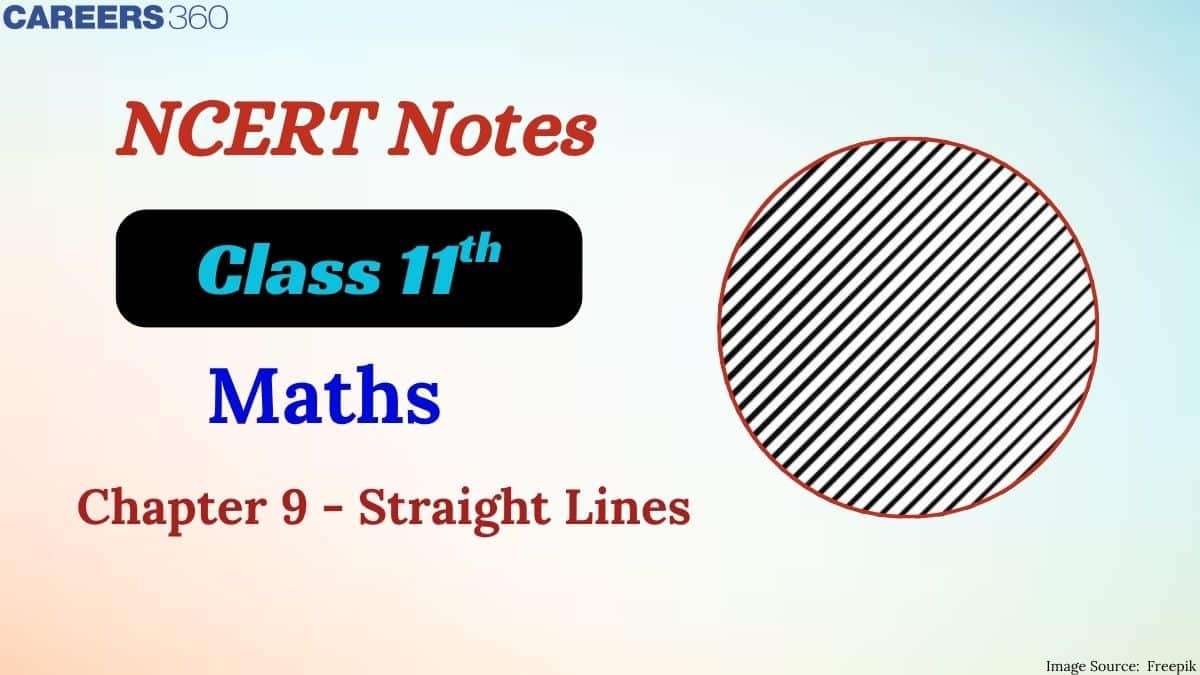
This article on NCERT notes for Class 11 Maths Chapter 9 Straight Lines offers well-structured NCERT notes to help students grasp the concepts of Straight Lines easily. Students who want to revise the key topics of straight lines quickly will find this article very useful. It will also boost the exam preparation of the students by many folds. These NCERT notes have been prepared by subject matter experts in accordance with the latest NCERT syllabus, ensuring that students can grasp the basic concepts effectively. Find everything in one place – NCERT Books, Solutions, Syllabus, and Exemplar Problems with Solutions – in this NCERT article.
Also, read,
Class 11 Straight Lines Notes PDF – Download Free Study Material
Students who wish to access these NCERT Class 11 Maths Chapter 9 Notes can click on the link below to download the entire notes in PDF.
Straight Lines Class 11 Notes
Careers360 experts have curated these NCERT Class 11 Maths Chapter 9 Notes to help students revise quickly and confidently.
Important formulas
1. The distance between two points $\mathrm{P}\left(\mathrm{x}_1, \mathrm{y}_1\right)$ and $\mathrm{Q}\left(\mathrm{x}_2, \mathrm{y}_2\right)$ is $d=\sqrt{\left(x_2-x_1\right)^2+\left(y_2-y_1\right)^2}$
2. The coordinate of the point which cuts a line segment joining by $P\left(x_1, y_1\right)$ and $Q\left(x_2, y_2\right)$ internally in ratio $m:n$ is $\left(\frac{m x_2+n x_1}{m+n}, \frac{m y_2+n y_1}{m+n}\right)$
3. If the ratio of $\mathrm{m}: \mathrm{n}=1: 1$ then the coordinate of the point is $\left(\frac{x_2+x_1}{2}, \frac{y_2+y_1}{2}\right)$
4. Area of the triangle whose vertices are $P\left(x_1, y_1\right), Q\left(x_2, y_2\right)$, and $R\left(x_3, y_3\right)$ is given by:
$A=\frac{1}{2}\left|x_1\left(y_2-y_3\right)+x_2\left(y_3-y_1\right)+x_3\left(y_1-y_2\right)\right|$
Slope of A Line
The steepness of a line is known as the slope of the line.
A line that is nonparallel to the x-axis cuts the x-axis at two angles. The angles are supplementary to each other. A line that makes an angle with the positive direction x-axis and the angle is measured anti-clockwise, then θ is the inclination of the line.
Definition: If a line makes an angle θ with the positive direction x-axis, then tanθ is the slope of the line.
The slope of a line is also denoted by the letter m.

Slope of a line when the coordinates of any two points on the line are given
When two points are given as (x1, y1) and (x2, y2) the slope is $m=\frac{y_2-y_1}{x_2-x_1}$
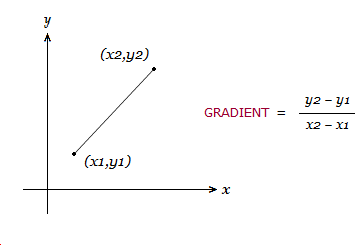
Conditions for Parallelism and Perpendicularity of Lines in Terms of Their Slopes
Parallel Lines
Let two lines l1 and l2 be parallel to each other. The slopes of lines l1 and l2 are m1 and m2. The inclinations of the lines l1 and l2 are α and β, respectively. The diagram is shown below
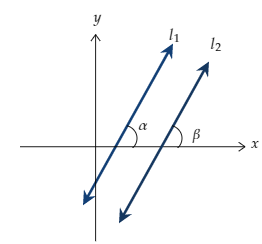
Since the lines are parallel to each other so the angle of inclination is also equal.
Hence, $α=β$
Taking $\tan$ both sides
$\tan α = \tan β$ and m1 = m2
The slope of line l1 = The slope of line l2
If the lines are parallel, then the slopes of the lines are also equal.
Perpendicular Lines
Let two lines l1 and l2 be perpendicular to each other. The slopes of lines l1 and l2 are m1 and m2. The inclinations of the lines l1 and l2 are α and β, respectively. The diagram is shown below
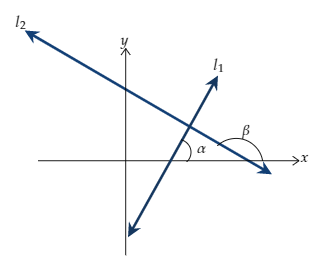
So, $β= α+90°$
Taking $\tan$ both sides
$\begin{aligned} & \tan \beta=\tan \left(\alpha+90^{\circ}\right) \\ &⇒ \tan \beta=-\cot \alpha \\ &⇒ \tan \beta=-\frac{1}{\tan \alpha} \\ &⇒ \tan \alpha \cdot \tan \beta=-1 \\ &⇒ m_1 m_2=-1\end{aligned}$
Two lines l1 and l2 are said to be perpendicular if m1m2 = -1
The Angle Between Two Lines
The inclination of two lines be θ1 and θ2 and θ1, θ2 ≠ 90°
The slopes of the lines are m1 = tanθ1 and m2 = tanθ2
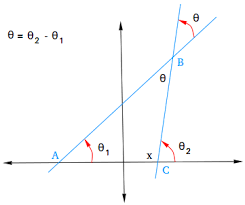
Assume that θ is the angle between the lines.
So,
$\begin{aligned} \tan \theta & =\tan \left(\theta_1-\theta_2\right) \\ & =\frac{\tan \theta_1-\tan \theta_2}{1+\tan \theta_1 \tan \theta_2} \\ & =\frac{m_1-m_2}{1+m_1 m_2}\end{aligned}$
Example 3.4
Find the acute angle between the lines $2x-y+3=0$ and $x+y+2=0$
Solution
Let $m_1$ and $m_2$ be the slopes of $2 x-y+3=0$ and $x+y+2=0$
Now $m_1=2, m_2=-1$
Let $\theta$ be the angle between the given lines
$ \tan \theta =\left|\frac{m_1-m_2}{1+m_1 m_2}\right| $
$ \Rightarrow \tan \theta=\left|\frac{2+1}{1+2(-1)}\right|=3 $
$⇒\theta =\tan ^{-1}{(3)}$
Collinearity Of Three Points
Let three points be A(1,4), B(4,6), and C(10,10) lie on the same line.
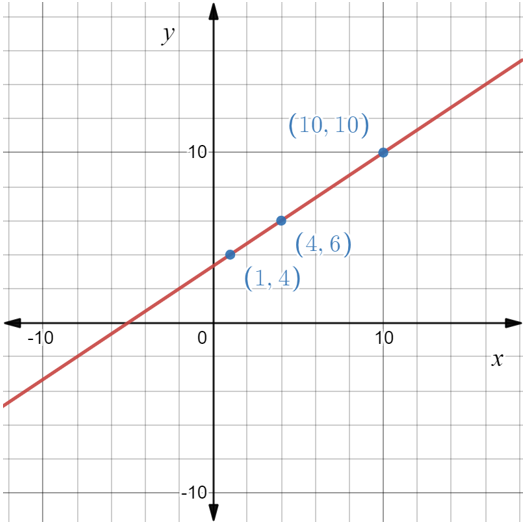
The slope of the line that passes through the points $A(1,4)$ and $B(4,6)$ is $\frac{6-4}{4-1}=\frac{2}{3}$
The slope of the line that passes through points $B(4,6)$ and $C(10,10)$ is $\frac{10-6}{10-4}=\frac{2}{3}$
So, mAB = mBC = $\frac{2}{3}$
If the points lie on the same line, then the slope of the line joining any two points is always the same.
Various Forms of the Equation of a Line
Horizontal and vertical lines
If a line is parallel to the x-axis, and the distance of the line from the x-axis is b units. Then the equation of the line is
Either $y=b$ or $y =-b$.
If a line is parallel to the y-axis, and the distance of the line from the y-axis is a unit. Then the equation of the line is
Either $x=a$ or $x=-a$
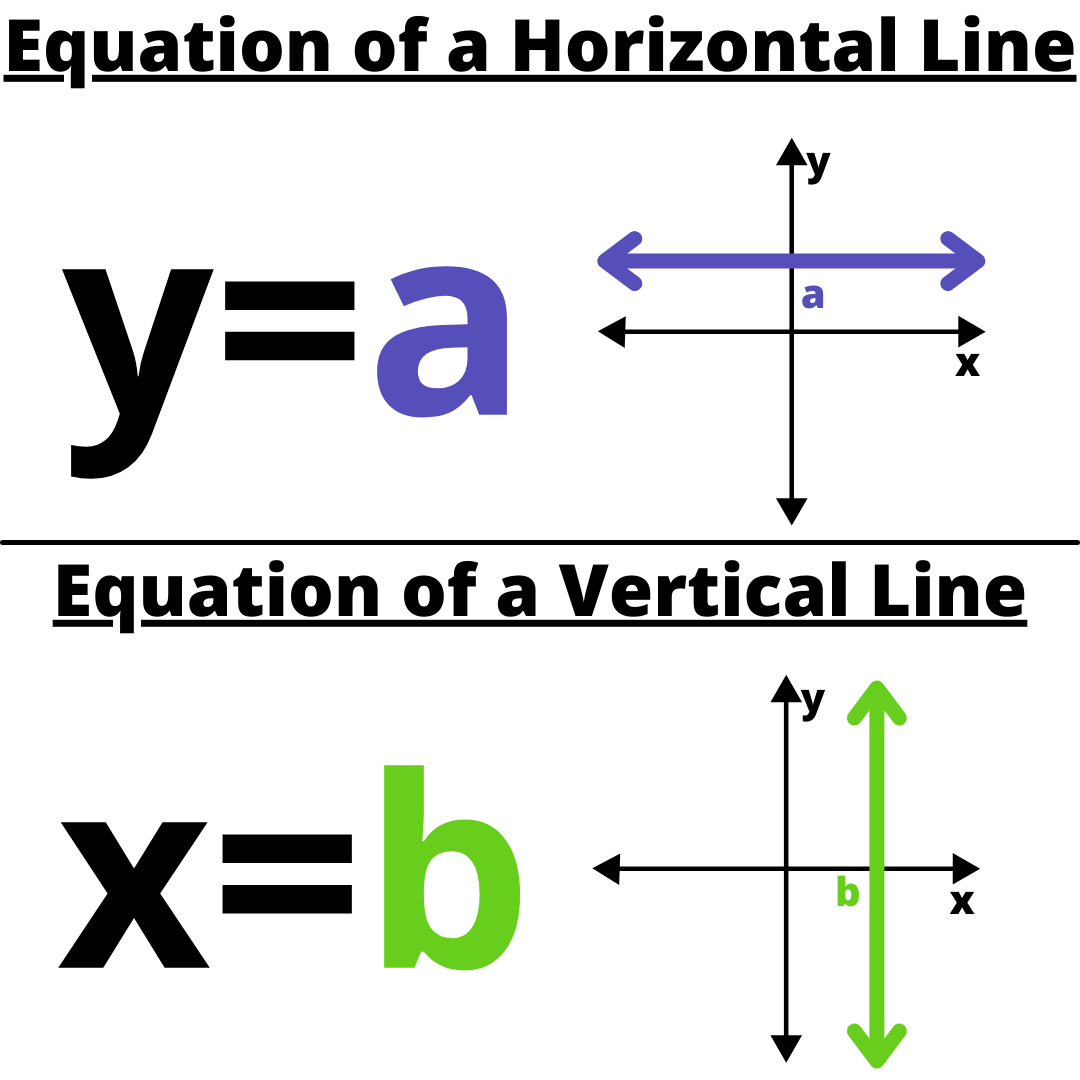
Point-Slope Form
Let a fixed point be (x1,y1) and an arbitrary point be (x,y).
Let m be the slope of the line.
Then $\frac{y-y_1}{x-x_1}=m$
$y-y_1=m\left(x-x_1\right)$
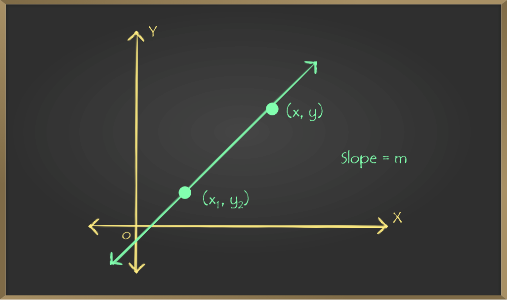
Two-point form
Let two points be (x1,y1) and (x2,y2) then
$y-y_1=\frac{y_2-y_1}{x_2-x_1}\left(x-x_1\right)$
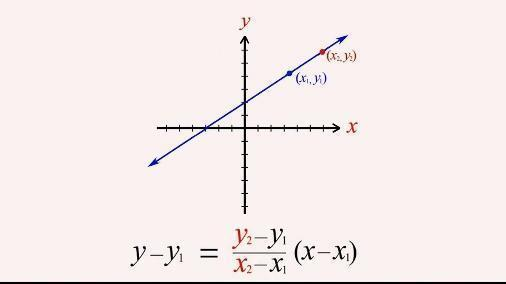
Slope-Intercept Form
Let the point on the y-axis be (0,b), and m is the slope of the line
Then the formula is $y=mx+b$
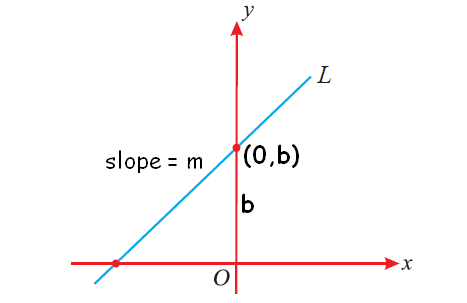
Intercept - Form
Let the points on the coordinate axes be (a, 0) and (0, b)
Then the equation
$\frac{x}{a}+\frac{y}{b}=1$
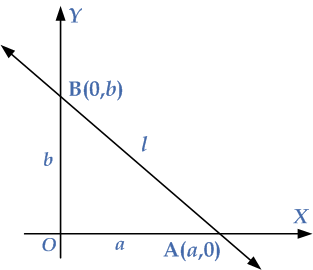
Normal Form
$x \cos \alpha+y \sin \alpha=p$
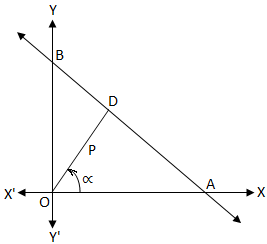
General Equation Of A Line
The general equation goes by $Ax+By+C=0$
Different forms of $Ax+By+C=0$
Slope-intercept form
$\begin{aligned} & B y=-A x-C \\ & y=-\frac{A}{B} x-\frac{C}{B} \\ & m=-\frac{A}{B} \text { and } c=-\frac{C}{B}\end{aligned}$
Intercept form
$\begin{aligned} & A x+B y+C=0 \\ &⇒ A x+B y=-C \\ &⇒ \frac{x}{-\frac{C}{A}}+\frac{y}{C}=1 \\ &⇒ \frac{x}{a}+\frac{y}{b}=1 \\ &⇒ a=-\frac{C}{A} \text { and } b=-\frac{C}{B}\end{aligned}$
Distance of a Point from a Line
Let P(x1, y1) be a point that does not lie on the line $Ax+By+C=0$.
Then the distance of the point P(x1, y1) from the line is
$d=\left|\frac{A x_1+B y_1+C}{\sqrt{A^2+B^2}}\right|$
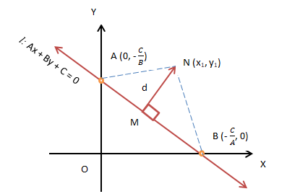
Distance Between Two Parallel Lines
Suppose the equations of two parallel lines be $Ax+By+C_1 = 0$ and $Ax+By+C_2 = 0$
Then the distance between two parallel lines is $d=\left|\frac{C_1-C_2}{\sqrt{A^2+B^2}}\right|$
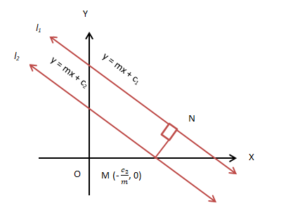
Straight Lines Class 11 Notes: Previous Year Question and Answer
Given below are selected previous year question answers for NCERT Class 11 Maths Chapter 9 Straight Lines, collected from various examinations.
Question 1:
The graph of the equation $x=a(a \neq 0)$ is a_____.
Solution:
Given: $x=a(a \neq 0)$
A diagram that shows the change of one variable to one or more other variables, such as a collection of one or more points, lines, line segments, curves, or regions.
The value of $x$ = The value of $a$ = 1, 2, 3, and so on to infinity.
The value of $y$ = constant (assume $y=4$)
As a result, the graph these points create will be a straight line parallel to the y-axis.
Hence, the correct answer is "a line parallel to the y-axis".
Question 2:
What is the slope of the line parallel to the line passing through the points (5, –1) and (4, –4)?
Solution:
Given: The points are (5, –1) and (4, –4).
$\text{Slope}=\frac{y_2–y_1}{x_2–x_1}$
Substitute the given values in the above formula, and we get,
$\frac{–4–(–1)}{4–5}=\frac{–3}{–1}$
So, the slope of the given line is 3. The slope of the line parallel to this line is also the same.
Hence, the correct answer is $3$.
Question 3:
At what point does the line $2x–3y = 6$ cut the Y-axis?
Solution:
Given:
The equation is $2x–3y = 6$
The Y-axis can be expressed as $x = 0$.
So, both lines should be satisfied at the intersection.
Substitute $x=0$ in the equation, $2x–3y = 6$, we get,
$(2×0)–3y = 6$
⇒ $y = –2$
The point is (0, –2), which satisfies both lines.
Hence, the correct answer is (0, –2).
Importance of NCERT Class 11 Maths Chapter 9 Notes
NCERT Class 11 Maths Chapter 9 Notes play a vital role in helping students grasp the core concepts of the chapter easily and effectively, so that they can remember these concepts for a long time. Some important points of these notes are:
- Effective Revision: These notes provide a detailed overview of all the important theorems and formulas, so that students can revise the chapter quickly and effectively.
- Clear Concepts: With these well-prepared notes, students can understand the basic concepts effectively. Also, these notes will help the students remember the key concepts by breaking down complex topics into simpler and easier-to-understand points.
- Time Saving: Students can look to save time by going through these notes instead of reading the whole lengthy chapter.
- Exam Ready Preparation: These notes also highlight the relevant content for various exams, so that students can get the last-minute guidance for exams.
NCERT Class 11 Maths Notes Chapter-Wise Links
For students' preparation, Careers360 has gathered all Class 11 Maths NCERT Notes here for quick and convenient access.
Subject-Wise NCERT Exemplar Solutions
After finishing the textbook exercises, students can use the following links to check the NCERT exemplar solutions for a better understanding of the concepts.
- NCERT Exemplar Class 11 Solutions
- NCERT Exemplar Class 11 Maths
- NCERT Exemplar Class 11 Physics
- NCERT Exemplar Class 11 Chemistry
- NCERT Exemplar Class 11 Biology
Subject-Wise NCERT Solutions
Students can also check these well-structured, subject-wise solutions for class 11.
- NCERT Solutions for Class 11 Mathematics
- NCERT Solutions for Class 11 Chemistry
- NCERT Solutions for Class 11 Physics
- NCERT Solutions for Class 11 Biology
NCERT Books and NCERT Syllabus
Before the start of a new academic year, students should refer to the latest syllabus to determine the chapters they’ll be studying. Below are the updated syllabus links, along with some recommended reference books.
Frequently Asked Questions (FAQs)
The slope (m) of a line represents its steepness or inclination with respect to the x-axis and is given by m = tanθ
The general equation of a straight line goes by ax + by + c =0, where a, b, and c are real constants.
It represents a line cutting the x-axis at ‘a’ and y-axis at ‘b’, written as x/a + y/b = 1
Absolutely. The chapter is fundamental for JEE Main, JEE Advanced, and NDA as it covers essential coordinate geometry concepts used in higher-level problems.
You can download the free NCERT Class 11 Maths Chapter 9 Notes PDF for Straight Lines directly from the official Careers360 website.
Courses After 12th
Applications for Admissions are open.
As per latest syllabus. Physics formulas, equations, & laws of class 11 & 12th chapters
JEE Main Important Chemistry formulas
Get nowAs per latest syllabus. Chemistry formulas, equations, & laws of class 11 & 12th chapters
JEE Main high scoring chapters and topics
Get nowAs per latest 2024 syllabus. Study 40% syllabus and score upto 100% marks in JEE
JEE Main Important Mathematics Formulas
Get nowAs per latest syllabus. Maths formulas, equations, & theorems of class 11 & 12th chapters
